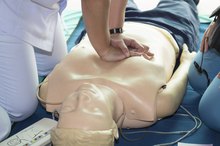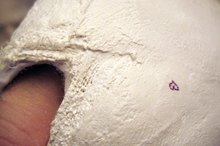What to Do If Someone Cuts an Artery?
Bleeding from an artery, the largest of the blood vessels that carry oxygenated blood away from the heart and around the body, is a life-threatening injury. You can usually identify an artery cut because the blood will be bright red (as opposed to dark red or maroon blood from a vein) and the blood will flow quickly--or even spurt from the wound. If you are faced with trying to assist someone who has cut an artery, it is critical that you get help immediately before trying first aid.
Calling emergency services is the absolute first step when dealing with anyone who has severe bleeding--no matter the source of the bleeding--an adult will enter shock after losing just two pints of blood. Preferably, ask an onlooker to dial 911, but if you must, contact emergency services yourself.
Remain calm. The sight of blood can easily induce panic and fear in non-professional rescuers, but understand that a cut artery is a time-critical wound, everything you do after calling 911 increases a person's chance of survival--if it is done correctly. Try and forget procedures you may have seen done on television or in the movies--these procedures are often inaccurately portrayed to increase drama. Instead, take a deep breath, hold it, and then let the breath out slowly to help calm yourself before approaching the bleeding person.
Preparing to Assist
How to Treat a cut on the bottom of a toe
Learn More
Assess the situation. Only provide assistance if the scene is safe, or the emergency personnel may treat two victims instead of one. If the scene is safe, then proceed carefully. If the person isn't already lying down, instruct them to do so--assisting as necessary. If it's possible, keep their head lower than their trunk to encourage blood flow to the brain.
If the person bleeding from an arm or a leg, elevate the wound above the heart to slow the bleeding. If you cannot elevate the wound, elevate the legs slightly instead. If you have access to any personal protective equipment such as gloves, place them on. If you can improvise using plastic bags, do so. But do not let a lack of protective equipment prevent you from offering first aid--just tell the emergency personnel when they arrive on the scene.
Slowing the Bleeding
Your job as a first responder to a bleeding victim is to slow the bleeding as much as possible. If you have experience with the correct placement of a tourniquet, then use one--either from a first aid or emergency kit or fashioned from cloth from a shirt--before placing direct pressure to the wound. If you do not have experience placing tourniquets, do not attempt to tie one on yourself. Instead, concentrate on placing direct pressure to the wound.
Use sterile gauze or dressing directly on the wound, if possible, but in a pinch, use any soft, clean cloth (such as a shirt or a jacket) and press over the wound firmly. Don't remove the dressing or the cloth once you have placed it on the wound. If blood soaks the dressing, place more dressing or cloth on top.
Continue placing pressure on the wound until emergency personnel arrive and take over the scene.
Related Articles
References
Resources
Writer Bio
A writer and professional lab assistant based in Seattle, Kate Bruscke has been writing professionally about health care and technology since 1998. Her freelance clients include "The Seattle Times," KGB.com, Reading Local: Seattle, Nordstrom and MSN/Microsoft. Bruscke holds a Master of Fine Arts from The School of the Art Institute of Chicago.









